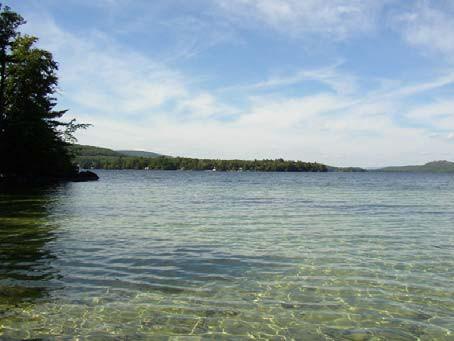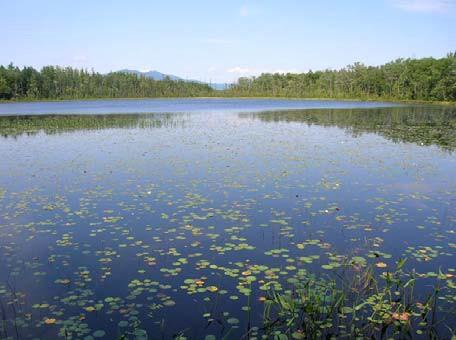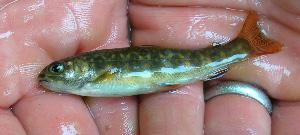Spotlight on Wildlife Action Plan Habitats: Defining Watersheds
New Hampshire's Wildlife Action Plan identifies 27 unique habitat types across the state. Many of these are easily recognized and definable, like grasslands or rocky ridges. Others require a bit more thought and consideration of how they should be defined, mapped, and managed.
Aquatic habitats fall into this category – and five classifications were developed to help conservation commissions, landowners, land trusts and planners better identify these important habitats, and better use the information available in the updated Wildlife Action Plan for conservation and management guidance.
New Hampshire has hundreds of lakes and ponds that provide different elements of wildlife habitat. Aquatic wildlife is often oxygen or temperature dependent, which are two closely linked variables. Because cold water holds more oxygen than warm water, this variable often determines which species can live in that environment. This was a major factor in determining how to classify the unique waterbodies in the state.
Lakes and Ponds with Coldwater Habitat include lakes with deep, well-oxygenated cold water that supports naturally reproducing populations of coldwater fish species. Coldwater fish species representative of this habitat type include (but is not limited to) lake trout, wild brook trout, rainbow and brown trout, and round whitefish, many of which have restricted ranges in New Hampshire. This habitat category also includes ponds at higher elevations (above 1,900 feet), which maintain cooler water temperatures despite their shallow depth. This category includes some of our favorite lakes: Winnipesauke, Newfound, and Sunapee, to name a few.

Although water quality in most lakes and ponds with coldwater habitat is relatively good, high levels of development along the shoreline and in the surrounding watersheds of some lakes may lead to issues, such as eutrophication, in the future. Photo by NHFG.
In contrast, Warmwater Lakes and Ponds are defined by their inability to support coldwater fish species due to a lack of cold, well-oxygenated water in the summer. Instead, warmwater lakes and ponds typically support warmwater species such as large and smallmouth bass, bluegill, and chain pickerel. These habitats are widespread in New Hampshire and they vary in size, shape, and depth. Waterbodies representative of this category include Pawtuckaway Lake, Pemigewasset Lake, Baboosic Lake, and Country Pond, along with many others.
A river is a river, right? The next few categories were developed to help sort this out. The mighty Merrimack and Connecticut Rivers fall into a category of their own: Large Warmwater Rivers. These are defined as having watersheds greater than 1,000 square miles. These rivers support a diverse array of both aquatic and terrestrial species, and are important habitat for many diadromous fish species, which migrate in large numbers from the ocean to spawn or live in freshwater.

Warmwater lakes and ponds tend to provide areas with aquatic vegetation that serve as spawning and nursery habitat for many fish species, and abundant invertebrate populations that attract turtles, amphibians, and fish. Photo by NHFG.
Warmwater Rivers and Streams are the next step down in watershed size. Typically, these rivers and streams have an average water temperature above 20*C during the summer, which is too warm for coldwater species like brook trout. Low gradient, slow flowing warmwater rivers and streams often contain submerged aquatic vegetation and share similarities with the shoreline habitat of warmwater lakes and ponds. Faster flowing warmwater rivers and streams may have the appearance of a coldwater stream, but they are home to a different community of fish species, including fallfish, longnose dace, and creek chubs.
Rivers and streams that are able to maintain cold water temperatures during hot summer months are categorized as Coldwater Rivers and Streams. The presence of coldwater fish species, including brook trout and slimy sculpin, is an indicator of coldwater river or stream habitat. Coldwater rivers and streams are more common to the north and at higher elevations where a cooler climate causes less warming throughout the summer.

The presence of juvenile brook trout in a stream, as opposed to hatchery raised fish, is a sign that the stream is capable of supporting a wild trout population. Photo by NHFG.
Each of the five aquatic habitats listed above have a fully developed profile in the Wildlife Action Plan – which includes a discussion of threats to the habitat and suggestions of what we can do to protect and enhance wildlife habitat at these locations. Which habitats exist in your community? The profiles for all 27 New Hampshire habitat types can be found on the NH Fish & Game Department website at www.wildlife.state.nh.us/wildlife/wap.html.


